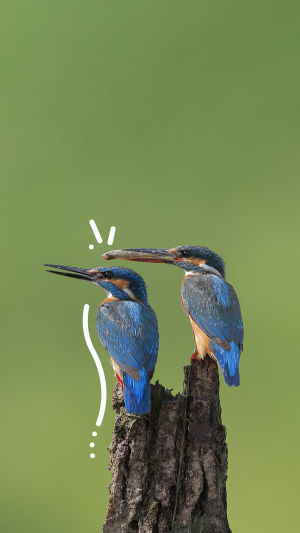Kingfishers often perch on branches or rocks near the water's edge to prey on fish and shrimp. With the exception of red beak and red legs, most of the body is emerald green.
In spring and summer, kingfishers carve holes in the steep banks of the river to build their homes. Kingfishers sometimes cut holes as deep as two and a half meters. When the female cuts the hole, the male delivers the fish, in perfect coordination. After building the nest, the kingfisher couple prepare to have children, laying up to four or five eggs in each clutch.
Although beautiful and cute, kingfishers are fierce hunters by nature. They always eat fish head first and shrimp tail first. If the head of the fish is facing outwards, it is meant to be fed to the young or presented to the courting partner. If the head is facing outwards, it is meant to be eaten by itself.
Kingfishers are not good at swimming, but they are excellent divers. They often stand on the branches of trees or rocks at the water's edge, quietly watching the fish swimming in the water. Once they see the target, they will fly into the water at once. The kingfisher also retains excellent vision when submerged, because its eyes can quickly adjust to the contrast in view caused by light in the water. So kingfishers are very good at catching fish. When they catch a fish, they take it quickly out of the water and fly back to where they were standing.
Kingfishers are medium-sized waterfowl, with blue-black forehead to pillow, turquoise blue stripes, emerald blue back and chestnut brown belly; pale horizontal patches on top of the head; the mouth and feet are red. Looks like a woodpecker from a distance. The feathers on its back and face are bright blue, so it is commonly called kingfisher. The food is mainly fish, and they also eat crustaceans and a variety of aquatic insects.
Kingfishers live in clear, slow-flowing rivers, streams, lakes and irrigation canals with shrubland or sparse forests. Lonely personality, usually alone perched on the branches or rocks near the water, waiting for opportunities to hunt. The food is mainly small fish, but also includes crustaceans and a variety of aquatic insects and their larvae, as well as small frogs and a few aquatic plants. After diving into the water, kingfisher can also maintain excellent eyesight, because its eyes into the water can quickly adjust the angle of view caused by the contrast, so their fishing ability is very strong.
There is another species of kingfisher, the woodsy kingfisher, which lives away from water and feeds on insects. The forest kingfisher is centered around Australia and New Guinea. The Kookaburra of Australia is the largest kingfisher and feeds on snakes and lizards. It usually burrows in the trees at a certain height above the ground to build nests and breed.
The kingfisher can burrow its large beak into earthen cliffs and nest in the tunnels of field embankments. There is usually no bedding at the bottom of the hole, and the eggs are laid directly on the nest floor. Six to seven eggs are laid in each clutch. Eggs pure white, slightly spotted. The size of eggs is about 28 mm ×18 mm, with one or two broods per year. The incubation period of kingfisher eggs is about 21 days. Both sexes incubate, but only the female birds feed the chicks.





